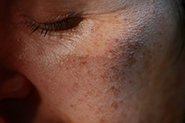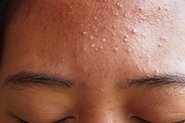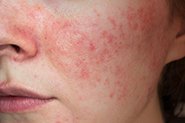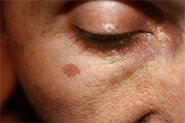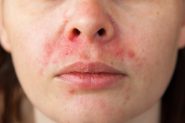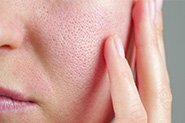
Qr8’s Founder, Dr Michele Squire, breaks down the research for you to answer your burning (or is that smoking!) questions…
We already know that smoking traditional tobacco cigarettes is associated with a long laundry list of skin issues. Smoking can delay wound healing (the reason patients undergoing surgery are asked to stop smoking several weeks before their surgery date), promotes overgrowth of pathogenic bacteria that can cause wound infections after oral and aesthetic procedures, and is associated with development of contact and atopic dermatitis, psoriasis, hidradenitis suppurative, and lupus. It is also a major cause of wrinkling and accelerates prematurely aged skin [1]. One study estimates that 10 years of smoking can add 2.5 years to our appearance [2]. There is also evidence that smoking contributes to a form of post-adolescent acne [3].
From an overall health perspective, e-cigarettes (‘e-cigs’ or ‘vapes’) were initially thought to be a safer, cleaner alternative to traditional cigarettes, and a useful aid for those wanting to quit smoking. We now know that neither of these are true. E-cigs deliver harmful substances to the lungs, produce harmful effects to the cardiovascular system, increase risk of both cardiovascular and lung disease, and aren’t an evidence-based support for smoking cessation. Vaping is now also seen as a gateway to traditional cigarette smoking – those who vape are more likely to become future tobacco smokers [4, 5].
So, with vaping on the rise, we turned to the scientific literature to understand if there are also skin issues associated with these devices.
How do e-cigs work?
E-cigs are simply a nicotine delivery device, designed to generate and deliver an inhalable nicotine vapour without the harmful carcinogens present in traditional cigarette smoke (smoke is produced by burning tobacco in a traditional cigarette).
The e-cig device contains a battery-operated coil that heats up to 100-250°C and converts a liquid (e-liquid, aka ‘e-juice’) housed in a screw-in cartridge, into steam. The user then inhales vapour via the device’s mouthpiece to mimic ‘smoking’. Reusable devices are refilled by replacing the screw-in e-liquid cartridge, which also offers users thousands of different flavour options.
Nicotine vaping products require a medical prescription in Australia, so a significant illicit market exists, which relies on imported products (typically disposable devices). These devices are known to have quality control issues with their batteries, and labelling of the ingredients is not always accurate, so the exact composition of their e-juice is often unknown.
What’s in e-liquid?
The e-liquid is composed of nicotine (up to a maximum of 2% v/v, although in reality, this amount can be much higher [6]) and flavourings, dissolved into a solvent. The solvent is 80-90% propylene glycol (PG), with glycerol (Gly) making up the remainder [7]. Nicotine-free versions are available, but the issues with labelling we discussed earlier means they may well contain nicotine.
Does vaping and e-cig aerosol damage skin?
E-cigs are fairly new devices, so the research is still new-ish (compared with the fifty plus years of research into cigarette smoking). There’s still a lot science doesn’t know about exactly what health effects vaping causes, especially as e-juice components, and usage patterns of vapes, vary dramatically. What’s clear though, is that, exhaled e-cig aerosol isn’t just harmless water vapour, although exactly how harmful it is, remains to be seen.
Needless to say, there are bigger issues at play here than skin damage, but since that’s what we’re all about, let’s explore how the major components of exhaled aerosol impact our skin:
Nicotine
Nicotine is internalised through the mouth and lungs during smoking, and is also the major component of exhaled cigarette smoke (technically called ‘third hand smoke’, THS). THS deposits on the skin, allowing nicotine to also be absorbed through the dermis. Nicotine is also present in exhaled e-cig aerosol [8], which also deposits on skin.
Nicotinic receptors are present within the skin – on the keratinocytes (‘skin cells’), fibroblasts (produce collagen, elastin, hyaluronic acid), and blood vessels. Nicotine binds to these receptors, and is thought to initiate effects such as diminished blood flow to the skin (with reduced nutrient/oxygen transfer), delayed wound healing and skin barrier repair, increased chance of infection, rough and thickened skin, changes to collagen and elastin production, and inflammation [9]. Several studies have shown no significant difference between tobacco cigarettes and nicotine-containing e-cigs when it comes to negative effects on blood flow, and oxidative stress [6]. So, regardless of the source (tobacco or e-liquid), nicotine isn’t a skin-friendly chemical.
Nickel
E-cig aerosol also contains nickel, released from the heating coil during the vaporisation process [10]. This has been the cause of a number of cases of nickel-related allergic contact dermatitis on the hands, as well as the lips and face [5].
Propylene Glycol
As the major constituent of e-liquid, it should come as no surprise that PG is also one of the major components of exhaled vapour. This chemical had the dubious honour of being named the American Contact Dermatitis Society’s Allergen of the Year for 2018 [11]. Enough said.
Flavourings/fragrances/aldehydes
We know that flavourings are present in expired aerosols along with their breakdown products: formaldehyde, acetaldehyde, and acrolein/propanal (coincidentally, these are the same 3 toxic aldehydes found in cigarette smoke) [12]. There’s no direct scientific evidence of a relationship between expired e-cig flavourings and skin issues, but these aldehydes are all known skin irritants (although exposure will vary according to the actual components of the e-liquid, and frequency of vaping). Regardless, for anyone with sensitive skin, a history of contact or allergic dermatitis (especially to fragrance mixes), or periorificial dermatitis, it’s possible that flavourings and their by-products emitted in e-cig aerosols may contribute to contact irritation/allergy.
Other dermatological conditions associated with e-cigs?
Flame burns, and lesions of the oral mucosa have also been reported with use of e-cigs [1,5].
Does vaping cause dry skin and acne?
Here’s some good news (finally!). Vaping is widely reported to result in dry skin, resulting from vasoconstriction and reduced blood flow. Many of these reports also suggest that dryness leads to excess sebum production, causing acne. Several studies show that reduced blood flow does not lead to dry skin [13, 14] so cannot drive acne formation. Myth, busted.
And finally…
Obviously, the degree to which any of this is a problem for you will depend on the quality of the e-cig/e-liquid you use, your vaping frequency/years of use, whether you choose a nicotine-free e-juice (and if it’s really nicotine free), and your personal pre-existing skin issues and condition. What’s clear, however, is that giving up smoking and vaping, is an excellent idea for your skin (and overall) health!,
This article only touches on the harms of e-cigarettes as they relate to skin. If you’re interested in the science behind e-cigarettes and their health effects CLICK HERE.
REFERENCES
- Mitri A, Lin G, Waldman RA, Grant-Kels JM. Effects of tobacco and vaping on the skin. Clin Dermatol. 2021 Sep-Oct;39(5):762-771. PMID: 34785004.
- Doshi DN, Hanneman KK, Cooper KD. Smoking and skin aging in identical twins. Arch Dermatol. 2007. PMID: 18087005.
- Capitanio B, Sinagra JL, Ottaviani M, Bordignon V, Amantea A, Picardo M. Acne and smoking. Dermatoendocrinol. 2009 May;1(3):129-35. PMID: 20436880.
- NHMRC, Australia’s national health council delivers assessment on electronic cigarettes, 23 June 2022.
- Visconti MJ, Ashack KA. Dermatologic manifestations associated with electronic cigarette use. J Am Acad Dermatol. 2019 Oct;81(4):1001-1007. PMID: 30965061.
- Marques P, Piqueras L, Sanz MJ. An updated overview of e-cigarette impact on human health. Respir Res. 2021 May 18;22(1):151. PMID: 34006276; PMCID: PMC8129966.
- Komura M, Sato T, et al. Propylene glycol, a component of electronic cigarette liquid, damages epithelial cells in human small airways. Respir Res. 2022 Aug 23;23(1):216. PMID: 35999544.
- Czogala J, Goniewicz ML, Fidelus B, Zielinska-Danch W, Travers MJ, Sobczak A. Secondhand exposure to vapors from electronic cigarettes. Nicotine Tob Res. 2014 Jun;16(6):655-62. PMID: 24336346; PMCID: PMC4565991.
- Misery L. Nicotine effects on skin: are they positive or negative? Exp Dermatol. 2004 Nov;13(11):665-70. PMID: 15500638.
- Williams M, Villarreal A, Bozhilov K, Lin S, Talbot P. Metal and silicate particles including nanoparticles are present in electronic cigarette cartomizer fluid and aerosol. PLoS One. 2013;8(3):e57987. PMID: 23526962; PMCID: PMC3603976.
- McGowan MA, Scheman A, Jacob SE. Propylene Glycol in Contact Dermatitis: A Systematic Review. Dermatitis. 2018 Jan-Feb;29(1):6-12. PMID: 29064881.
- Ogunwale MA, Li M, Ramakrishnam Raju MV, Chen Y, Nantz MH, Conklin DJ, Fu XA. Aldehyde Detection in Electronic Cigarette Aerosols. ACS Omega. 2017 Mar 31;2(3):1207-1214. doi: 10.1021/acsomega.6b00489. Epub 2017 Mar 29. PMID: 28393137; PMCID: PMC5377270.
- Yoshida-Amano Y, Nomura T, Sugiyama Y, Iwata K, Higaki Y, Tanahashi M. Dry skin conditions are related to the recovery rate of skin temperature after cold stress rather than to blood flow. Int J Dermatol. 2017 Feb;56(2):176-183. doi: 10.1111/ijd.13436. Epub 2016 Dec 4. PMID: 27917468.
- Ishihara M, Itoh M, Ohsawa K, et al. Cutaneous blood flow. Cutaneous Aging. Tokyo, Japan: University of Tokyo Press, 1988: 167–181
WOULD YOU LIKE TO CHAT TO ONE OF OUR FRIENDLY DOCTORS ABOUT YOUR SKIN CONDITION?
CLICK HERE TO BOOK A CONSULT WITH OUR EXPERIENCED MEDICAL TEAM.


